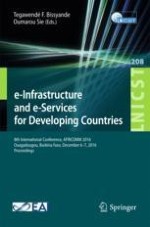2018 | Book
e-Infrastructure and e-Services for Developing Countries
8th International Conference, AFRICOMM 2016, Ouagadougou, Burkina Faso, December 6-7, 2016, Proceedings
Editors: Tegawendé F. Bissyande, Oumarou Sie
Publisher: Springer International Publishing
Book Series : Lecture Notes of the Institute for Computer Sciences, Social Informatics and Telecommunications Engineering
